By late April, lakesides and ditches across much of England are ringing to the rhythms of reed warblers.
Reed warblers make all kinds of noises, but they like to repeat a short phrase two or three times, change, repeat something else a few times, and change again.
It’s like the approach taken by the song thrush, but reed warblers don’t pause between the changes.
They can chug away continuously for minutes on end. In beats per minute they’re high-tempo disco or hard rock. Around about I’m So Excited by the Pointer Sisters or Riff Raff by AC/DC.
Occasional, isolated sounds from reed warblers can be tricky to pin down. Birds are often tucked out of sight, hidden among a fringe of reeds, or out in the thick of a reedbed.
From there they can tease the listener with anonymous croaks and churring sounds.
But once warmed up, reed warblers give themselves away with that rhythm, and reveal their repertoire.
Like many other warblers, reed warblers are skilful mimics and like to stitch other species’ signature noises into their songs. You might hear swallow or blue tit or lapwing sounds in there.
(Listen at 54 and 58 seconds in to the recording above and you can hear a blackbird’s alarm call.)
Though often hard to see at first, reed warblers sometimes move around while they sing, and have a habit of jumping up the reed stems until they’re in view.
The plain brown colouring of the upperparts, the strong bill and pale throat are the clearest features. The lack of strong stripes on the head separates them from the very similar-sounding sedge warbler.
Reed warblers continue to sing longer than many of our other summer songbirds, and can often still be heard through July. They raise one or two broods, mainly of their own young, but including a few cuckoos too.
By August noisy family parties are mainly talking to one another in dirty squeaks and churrs, before they begin to disappear back to central and southern Africa in early autumn.
The reed warbler (sometimes referred to as Eurasian or common reed warbler, to differentiate it from Blyth’s reed warbler, great reed warbler and others) is found across Europe and much of southwestern Asia in the summer. In the UK, there are now around twice the number of breeding pairs than there were in the 1960s, with their range having expanded further into Wales, to the east side of the island of Ireland, and into southern Scotland. For more on the ecology of the reed warbler in the UK, visit the BTO website.
For jazz variations: Sedge Warbler
Free event: Shriek of the Week meets BirdNote
When is a robin a thrush? How did Shakespeare change the ecology of the Americas? What unites people around nature on both sides of the Atlantic, and beyond?
These are the kinds of questions that have come up over the three years that Shriek of the Week has been putting birdsong in email inboxes.
BirdNote puts out a daily show about birds that is syndicated to public radio in the United States and is heard by some 3 million people every day. Being audio, it's often the birdsong that's at the heart of this content.
So who better to speak to about what unites us birdsong listeners in Europe and the US, and maybe where we confuse each other too?
I'm delighted to have some time with Conor Gearin and Bibi Baksh-Pabion, two of the team at BirdNote, for us to find out more about what they do and why, and to compare notes on birdsong in each of our respective 'patches'.
Join us for an hour of inspiring conversation and a transatlantic 'name that tune' quiz where we can all learn some birdsong from the other side of the pond (whichever side we're on).
Find more birds with Birdsong Academy this spring:
Half-day birdsong ID workshop in Stanmer Park (Brighton) - Saturday 18 May
Totally fabulous event… Really appreciate your warm human gentle teaching - thank you. - Maggie, Brighton
Dawn chorus experience with nightingales and Swedish pastries, at The Secret Campsite, East Sussex on Friday 10 May.
Many, many thanks for a beautiful and informative bird song chorus - the three of us loved it! So much info and so relaxed. - Helen, Eastbourne
Up With The Birds - our final ‘crowdsourced dawn chorus’ of the spring (free, Saturday 4 May, 5.30 - 6.30am)
Thanks for reading and listening. This is instalment #17 in 2024’s cycle of Shriek of the Week. You can catch up with Cuckoo, Willow Warbler, Swallow, Green Woodpecker, Blackcap, Nuthatch, Starling, Chiffchaff, Collared Dove, Wren, Dunnock, Great Spotted Woodpecker, Robin, Great Tit, Song Thrush and Blackbird (that last one includes an explanation of how this all works in 2024).
Many thanks to Tom Cadwallender for giving us his talk ‘The Bird of Alnmouth’ last week.
Media credits:
Reed warbler song recorded by Aubrey John Williams and distributed via the British Library under Creative Commons licence CC BY 3.0 DEED
Reed warbler image by Franz Wandevalle on Flickr, reproduced under CC licence CC BY-NC 2.0 DEED
Sedge warbler image by Georg_Wietschorke




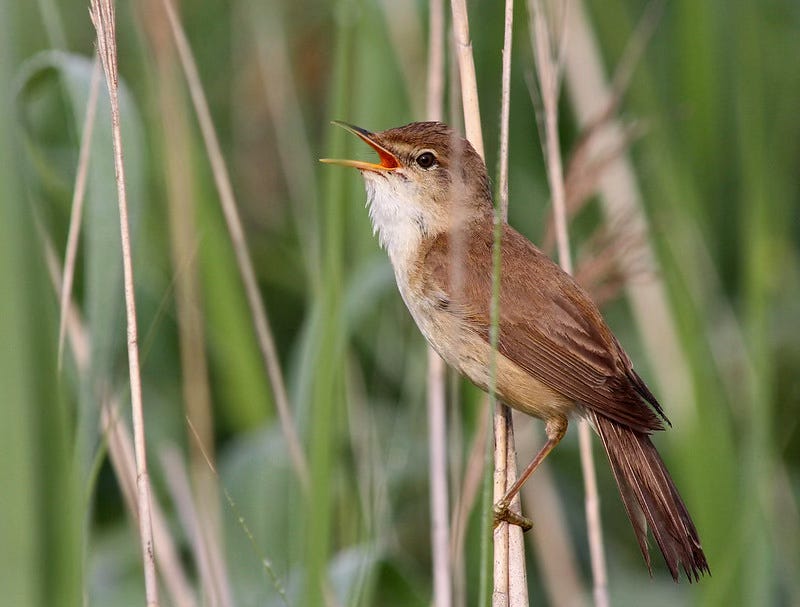




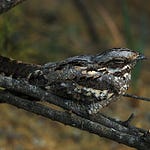
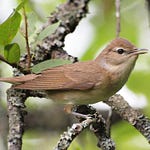

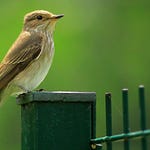


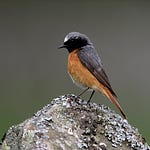

Share this post